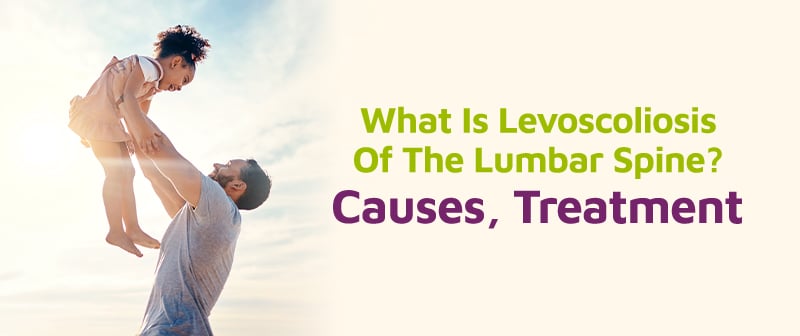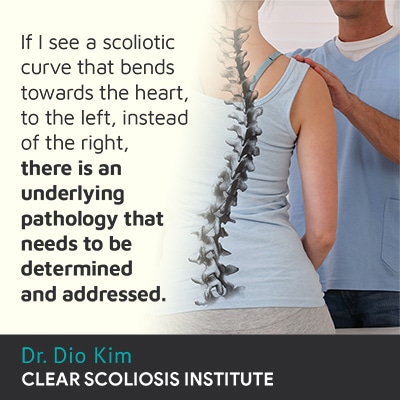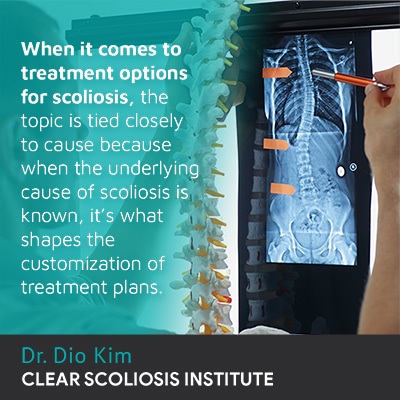
Scoliosis is a highly-prevalent spinal condition that’s been around for hundreds of years. As our understanding of the condition has grown over those years, so too has our experience with different types of treatment. We also understand what a right- versus a left-bending scoliotic curve indicates; continue reading to learn why the difference is important.
A diagnosis of levoscoliosis of the lumbar spine means an unnatural spinal curve that bends to the side and twists has developed in the lumbar spine. Levo means to the left, so the scoliotic curve atypically bends to the left, rather than typical curves that bend to the right.
Let’s start our discussion of levoscoliosis by first exploring how the condition can affect the spine and body in general.
The scoliotic spine is one that bends unnaturally to the side, and in addition, it also has a rotational component, meaning it twists unnaturally, and this is what makes scoliosis a 3-dimensional condition.
In addition, in order to be diagnosed as scoliosis, the abnormal spinal curve has to have a minimum Cobb angle of 10 degrees, and this is a measurement that also determines condition severity.
The higher the Cobb angle, the larger the unnatural curvature of the spine, the more severe the condition is, and the further out of alignment the spine’s vertebrae are:
When the spine can maintain its natural and healthy curves, its vertebrae (bones) are stacked on top of one another (aligned), but if the spine develops an unnatural spinal curve, some vertebrae have become excessively tilted, and the spine is no longer in an optimal alignment; this can cause a number of problems.
Scoliosis is also progressive in nature, so it’s important for patients to understand that even if diagnosed as mild, scoliosis isn’t a static condition and can progress to moderate and severe, especially when treatment isn’t applied.
There are also three main sections of the spine, and scoliosis can develop in any: the cervical spine, thoracic spine, and the lumbar spine.
The cervical spine consists of the neck; the thoracic spine is the largest and includes the upper and middle back, while the lumbar spine refers to the lower back.
Each spinal section has its own unique roles and responsibilities, but the lumbar spine is particularly vulnerable to a number of conditions and issues.

It’s said that everyone will experience lower back pain at some point in their lives, and this is why the lumbar vertebrae are often referred to as the stress vertebrae: they have to support the weight of the torso, the thoracic and cervical spinal sections above, and they feel the effects of strenuous bending, lifting, and twisting maneuvers.
Now, in addition to different curvature locations, there are also different types of scoliosis, and this is determined by a condition’s underlying cause, and this is where the levo designation comes in.
Part of diagnosing scoliosis involves further classifying it based on a number of important patient and condition characteristics: patient age, condition severity, curvature location, and condition type.
The most common type of scoliosis is classified as idiopathic scoliosis, which means we don’t fully understand what causes the condition to develop initially, but we do know that it’s growth that causes it to progress.
Idiopathic scoliosis accounts for approximately 80 percent of scoliosis cases, with the remaining 20 percent corresponding with known causes: neuromuscular, degenerative, congenital, and traumatic.
The reason condition type is important for our current purposes is that in typical idiopathic scoliosis cases, the scoliotic curve bends to the right, away from the heart.
If I see a scoliotic curve that bends towards the heart, to the left, instead of the right, there is an underlying pathology that needs to be determined and addressed.
So to break down the term levoscoliosis of the lumbar spine, levo means to the left, and scoliosis means an unnatural sideways-bending and twisting spinal curve, and lumbar refers to the lower back, so levoscoliosis of the lumbar spine means a scoliotic curve that atypically bends to the left has developed in the lower back.
Dextroscoliosis refers to typical cases where the scoliotic curve bends away from the heart, to the right.
So now that we have fully defined the condition by breaking down the term, let’s talk about the different causes and treatment options for levoscoliosis of the lumbar spine.
When it comes to treatment options for scoliosis, the topic is tied closely to cause because when the underlying cause of scoliosis is known, it’s what shapes the customization of treatment plans.
When levoscoliosis is neuromuscular, this means the atypical direction of the curve has developed because of a larger neuromuscular condition causing a disruption in communication between the brain, the spine, and the spine’s surrounding tissues and muscles: meaning the spine isn’t receiving the support it needs to maintain its healthy curves and alignment.
These cases are atypical because the scoliosis is caused by another condition, so the underlying condition causing the scoliosis will drive the course of treatment.
Degenerative scoliosis is common in older adults as the spine degenerates over time, just like the rest of the body.
Most often, it’s the spine’s intervertebral discs that are the first structures to start to deteriorate, and as the discs provide the spine with structure, a change in their health and position can cause a change in the position of adjacent vertebrae, causing them to become misaligned with the rest of the spine and an unnatural spinal curvature to develop.

While a curvature reduction is always the goal, when it comes to treating degenerative scoliosis in adults, the focus is more on reducing a curve back to where it was prior to becoming painful, preserving spinal function, preventing further damage, and increasing spinal stability.
Chiropractic adjustments and scoliosis-specific exercises can help increase muscle strength to improve spinal support and stabilization, and can also help improve the health of affected discs by increasing the circulation in their surroundings, and/or realigning the spine so tilted vertebrae aren’t applying uneven pressure to the spinal discs.
Congenital scoliosis is a rare type and is caused by a malformation that occurred in the spine as it developed in utero; babies are born with the condition.
This is another atypical type that can explain a scoliotic curve bending to the left, and while surgery is sometimes needed, conservative treatment plans can be adjusted to address the challenges of treating patients of such a young age, and monitoring for progression, and any other signs of malformed parts/systems within the body, is a focus of treatment.
Traumatic scoliosis can be caused by an accident and/or trauma experienced by the spine; this can include spinal tumors pressing on the spine and forcing it out of alignment, or an injury that has damaged the spine.
With traumatic scoliosis, the cause of the trauma has to be addressed.
Levoscoliosis of the lumbar spine is the development of an unnatural scoliotic curve in the lower back that bends to the left, which is considered atypical as most cases of scoliosis feature curves that bend away from the heart: to the right.
Here at the CLEAR Scoliosis Institute, our team of scoliosis chiropractors have experience treating every type of scoliosis there is, levoscoliosis of the lumbar spine included.
When it comes to effective treatment options, they have to address a condition’s underlying cause whether that be idiopathic, neuromuscular, degenerative, or congenital.
As a CLEAR-certified scoliosis chiropractor, I treat my scoliosis patients with a proactive chiropractic-centered conservative treatment approach because a surgical response is invasive, and while it might make a spine straighter, it can do so at the cost of the spine’s natural range of motion and flexibility.
When there is a significant loss in spinal flexibility and range of motion, this can affect overall quality of life, and a spine that’s treated by more natural methods is one that’s going to be stronger and more functional into the future.

CLEAR provides a unique and innovative way of understanding scoliosis. Sign up to receive facts and information you won’t find anywhere else.

I have just been diagnosed with Levoscoliosis of the lumbar spine. The invormation I just read is very informative. I meed with my doctor later this month but now at least I have an idea of what is going on with my body. Thank you for the explanation in detail.